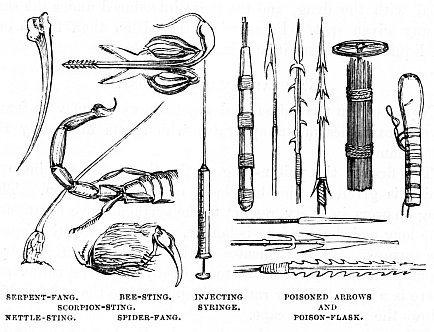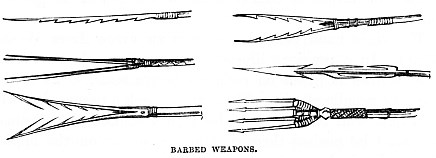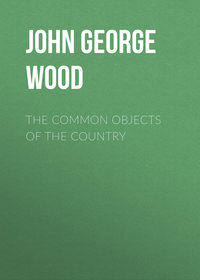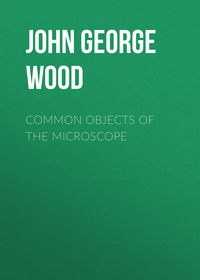 полная версия
полная версияNature's Teachings
A bundle of these tiny arrows, surmounted by the little wheel which is used to guard the hand from being pricked, is seen next to the Bornean poison-flask.

Beside these little arrows, which are only about ten inches in length, very much larger arrows are used both for war and hunting, and are propelled by the bow, and not with the breath. Many of these arrows are nearly six feet in length. In all, the head is movable fitting quite loosely into a socket, so that when an animal is struck and springs forward, the shaft is shaken off, to be picked up by the hunter, and fitted with another point, while the poisoned head remains in the wound.
Another kind of poison, also of a vegetable origin, is used by the Fan tribe. The arrows are mere little slips of bamboo, and are propelled by a slight crossbow. But the poison is so potent, that even these tiny weapons produce a fatal effect.
Nearly in the centre of the illustration is seen a rather curiously formed syringe, with an extremely long and slender tip. This is a recently invented instrument, used for the purpose of subcutaneous injection—i.e. of injecting any liquid under the skin. It is mostly employed for injecting opium and other drugs of similar qualities, for the purpose of obtaining relief from local pain. The slender spike-like point is hollow, and ends in a sharp tip, formed like the head of a lance. Just below the head there is a little hole, communicating with the interior of the tube.
The mode of operating is simple enough. The syringe is filled with the drug, and the point introduced under the skin at any given spot. Pressure on the piston then forces out the liquid, and causes it to mix with the blood.
Natural Animal PoisonsNow, both in the animal and vegetable worlds may be found several examples of an apparatus which acts in exactly the same manner.
The first is the poison-fang of the Serpent, a specimen of which is given on the left hand of the illustration. This fang answers in every respect to the syringe above mentioned. The long and slender fang is hollow, and answers to the pipe of the syringe. It communicates at the base with a reservoir of liquid poison, which answers to the body of the syringe, and there is a little hole, or rather slit, just above the point, which allows the poison to escape.
When the serpent makes its stroke, the base of the fang is driven against the reservoir, so that the liquid is urged through the hollow tube, and forced into the wound. Even in large serpents these fangs are very small. I have now before me some fangs of the cobra, puff-adder, rattlesnake, and viper, and it is astonishing how small and slender are these most deadly weapons. The figure in the illustration is much magnified, in order to show the aperture at the base, where communication is made with the interior of the fang. As the exit hole is on the upper curve of the fang, it is not visible in the figure.
Next to the serpent’s fang is a representation of the Bee-sting, the poisonous reservoir being seen at the base, and having attached to it the tiny thread-like gland by which the poison is secreted.
In the centre is seen the tail of a Scorpion, with its hooked sting. The last joint is formed just like the serpent’s fang, being hollow, having a sharp point with a slit near the end, and a poison reservoir in the rounded base. When the scorpion attacks an enemy, it strikes violently with the tail, and the force of the blow drives out the poison just as is done with the serpent’s fang.
At the bottom of the illustration is shown the poison-fang of a Spider, which, as the reader may see, is formed just on the principle of the scorpion-sting.
Natural Vegetable PoisonsSo much for animal poisons. We will now pass to the vegetable world.
Of the vegetable sting-bearers none are more familiar to us than the Nettle, three species of which inhabit this country. The two commonest are the Great Nettle (Urtica diœcea) and the Small Nettle (Urtica urens), and both of them are armed with venomous stings, which cause the plants to be so much dreaded.
The structure of these stings is very simple, and can be made out with an ordinary microscope, or even a good pocket lens. Each of these stings is, in fact, a rather elaborately constructed hair, hollow throughout its length, coming to a point at the tip, and having the base swollen into a receptacle containing the poisonous juice. When any object—such, for example, as the human hand—touches a nettle, the points of the stings slightly penetrate the skin, and the hair is pressed downwards against the base, so that the poison is forced through the hole.
One of these hairs is shown in the left-hand bottom corner of the illustration.
Even the tiny stings of our English nettles are sufficiently venomous to cause considerable pain, and, in some cases, even to affect the whole nervous system. But some of the exotic nettles are infinitely more formidable, and are, indeed, so dangerous that, when they are grown in a botanical garden, a fence is placed round them, so as to prevent visitors even from touching a single leaf.
The two most dreaded species are called Urtica heterophylla and Urtica crenulata. The former is thought to be the more dangerous of the two, and a good idea of its venomous qualities may be gathered from an account of an adventure with Urtica crenulata. The narrator is M. L. de la Tour.
“One of the leaves slightly touched the first three fingers of my left hand; at the time I only perceived a slight pricking, to which I paid no attention. This was at seven in the morning. The pain continued to increase, and in an hour it became intolerable; it seemed as if some one were rubbing my fingers with a hot iron. Nevertheless, there was no remarkable appearance, neither swelling, nor pustules, nor inflammation.
“The pain spread rapidly along the arm as far as the armpit. I was then seized with frequent sneezing, and with a copious running at the nose, as if I had caught a violent cold in the head. About noon I experienced a painful attack of cramp at the back of the jaws, which made me fear an attack of tetanus. I then went to bed, hoping that repose would alleviate my suffering, but it did not abate. On the contrary, it continued nearly the whole of the following night; but I lost the contraction of the jaws about seven in the evening.
“The next morning the pain began to leave me, and I fell asleep. I continued to suffer for two days, and the pain returned in full force when I put my hand into water. I did not finally lose it for nine days.”
There is another of these formidable nettles, called in the East by a name which signifies “Devil’s Leaf,” and which is sufficiently venomous to cause death. There is but little doubt, however, that in the present instance, if a larger portion of the body—say the whole arm—instead of three fingers, had been stung, death would have ensued from the injury.
The BarbWe now come to another improvement, or rather addition, in the various piercing weapons. Sometimes, as in the case of the dagger or the hand-spear, it was necessary that when a blow had been struck the weapon should be easily withdrawn from the wound, so as not to disarm the assailant, and to enable him to repeat the stroke if needful. But in the case of a missile weapon, such as a javelin or an arrow, it was often useful, both in war and hunting, to form the head in such a way that when it had once entered it could scarcely be withdrawn. For this purpose the Barb was invented, taking different forms, according to the object of the weapon and the nationality of the maker.
As in this work I prefer to show the gradual development of human inventions, I shall take my examples of barbs entirely from the weapons of uncivilised nations, six examples of which are given in the accompanying illustration, and five of them being drawn from specimens in my collection.

The upper left-hand figure is rather a curious one, the position of the barbs being nearly reversed, so that they serve to tear the flesh rather than adhere to it. The opposite figure represents an arrow with a doubly barbed point. It is chiefly used for shooting fish as they lie dozing on or near the surface of the water, but it is an effective weapon for ordinary hunting purposes, and, as the shaft is fully five feet in length, is quite formidable enough for war.
The left-hand bottom figure represents a very remarkable instrument, for it can hardly be called a weapon, and is, in fact, the head of a policeman’s staff. It is peculiar to Java, and is called by the name of “Bunday.” As may be seen by reference to the illustration, the head of the Bunday is formed of two diverging slips of wood. To each of these is lashed a row of long and sharp thorns, all pointing inwards, and the whole is attached to a tolerably long shaft.
When a prisoner is brought before the chief, a policeman stands behind him, armed with the Bunday, and, if the man should try to escape, he is immediately arrested by thrusting the weapon at him, so as to catch him by the waist, neck, or arm, or a leg. Escape is impossible, especially as in Java the prisoner wears nothing but his waist-cloth.
A weapon formed on exactly the same principle was used in the fifteenth and sixteenth centuries, and was employed for dragging knights off their horses. It was of steel instead of wood, and the place of the thorns was taken by two movable barbs, working on hinges, and kept open by springs. When a thrust was made at the knight’s neck the barbs gave way, so as to allow the prongs to envelop the throat, and they then sprang back again, preventing the horseman from disengaging himself. This weapon is technically named a “catchpoll.”
An illustration of one of these weapons will be given on another page.
The right-hand central figure is an arrow from Western Africa. In a previous illustration (page 65) a head of one of these arrows is given on rather a larger scale, so as to show the very peculiar barbs. These are of such a nature that when they have well sunk into the body they cannot be withdrawn, but must be pushed through, and drawn out on the opposite side. This is drawn from one of my own specimens.
In some cases, with an almost diabolical ingenuity, the native arrow-maker has set on a couple of similar barbs, directed towards the point, so that the weapon can neither be pushed through nor drawn back. One of these arrows is shown in the illustration, but, for want of space, the artist has placed the opposing barbs too near each other.
In some parts of Southern Africa a similar weapon was used for securing a prisoner, the barbed point being thrust down his throat and left there. If it were pushed through the neck it killed him on the spot, and if it remained in the wound the man could not eat nor drink, and the best thing for him was to die as soon as he could.
With similar ingenuity, the Tongans and Samoans made their war-spears with eight or nine barbs, and, before going into action, used to cut the wood almost through between each barb, so that when the body was pierced, the head, with several of the barbs, was sure to break off and leave a large portion in the wound. In Mariner’s well-known book there is an admirable account of the mode employed by a native surgeon for extracting one of these spear-heads. So common was this weapon that every Tongan gentleman carried a many-barbed spear about five feet long, and used it either as a walking-stick or a weapon. It is needless to say that this spear is almost an exact copy of the tail-bone of the Stingray. A dagger made of this bone was used in the Pelew Islands in 1780, but seemed to be rather scarce.
The left-hand central figure is a Fijian fish-spear of four points, and the last figure on the right hand represents a large four-pronged spear of Borneo. Both these weapons are in my collection.
Another example of a weapon where a large and powerful barb is needful is the Harpoon. As the harpoon is used in capturing the whale, the largest and most powerful of living mammalia, it is evident that a barb which will hold such a prey must be rather peculiarly made. The head and part of the shaft of the harpoon are shown in the right-hand figure of the accompanying illustration.

The left-hand figure represents a curious parasitic crustacean, popularly called the Sprat-sucker, because it is usually found on sprats. It affixes itself mostly to the eye, the deeply barbed head being introduced between the eye and the socket. In some seasons this remarkable parasite is quite plentiful, while in others scarcely a specimen can be found. Its total length is slightly under an inch, and its scientific name is Lernentoma Spratti.
The following graphic account of some prototypic weapons belonging to a marine worm is given by Mr. Rymer Jones, and is well worthy of perusal, not only for the vividness of the description, but for its exact accuracy:—
“Here is a Polynoe, a curious genus, very common under stones at low water on our rocky shores.
“It is remarkable on several accounts. All down the back we discover a set of oval or kidney-shaped plates, which are called the back-plates (dorsal elytra); these are flat, and are planted upon the back by little footstalks, set on near the margin of the under surface: they are arranged in two rows, overlapping each other at the edge. These kidney-shaped shields, which can be detached with slight violence, are studded over with little transparent oval bodies, set on short footstalks, which are, perhaps, delicate organs of touch. The intermediate antennæ, the tentacles, and the cirrhi or filaments of the feet, are similarly fringed with these little appendages, which resemble the glands of certain plants, and have a most singular appearance.
“If we remove the shields, we discover, on each side of the body, a row of wart-like feet, from each of which project two bundles of spines of exquisite structure. The bundles, expanding on all sides, resemble so many sheaves of wheat, or you may more appropriately fancy you behold the armoury of some belligerent sea-fairy, with stacks of arms enough to accoutre a numerous host.
“But, if you look closely at the weapons themselves, they rather resemble those which we are accustomed to wonder at in missionary museums,—the arms of some ingenious but barbarous people from the South Sea Islands,—than such as are used in civilised warfare. Here are long lances, made like scythe-blades, set on a staff, with a hook on the tip, as if to capture the fleeing foe, and bring him within reach of the blade. Among them are others of similar shape, but with the edge cut into delicate slanting notches, which run along the sides of the blade like those on the edge of our reaping-hooks.
“These are chiefly the weapons of the lower bundle; those of the upper are still more imposing. The outermost are short curved clubs, armed with a row of shark’s teeth to make them more fatal; these surround a cluster of spears, the long heads of which are furnished with a double row of the same appendages, and lengthened scimitars, the curved edges of which are cut into teeth like a saw.
“Though a stranger might think I had drawn copiously on my fancy for this description, I am sure, with your eye upon what is on the stage of the microscope at this moment, you will acknowledge that the resemblances are not at all forced or unnatural. To add to the effect, imagine that all these weapons are forged out of the clearest glass instead of steel; that the larger bundles may contain about fifty, and the smaller half as many each; that there are four bundles upon every segment, and that the body is composed of twenty-five such segments, and you will have a tolerable idea of the garniture and armature of this little worm, which grubs about in the mud at low-water mark.”

Somewhere between the fifteenth and sixteenth centuries a sort of anomalous weapon was in use, namely, a dagger, with a number of very deep and bold barbs. It was not, however, employed for offence, but for defence, and was used in the “rapier and dagger” mode of fighting, when the dagger, which was held in the left hand, was employed to parry the thrusts of the rapier, which was held in the right. From the mode of holding it, the weapon was called “Main Gauche.”
Sometimes the blade was quite plain, and, indeed, an ordinary dagger answered the purpose. But in most cases the Main Gauche was made for this special purpose, and was furnished either with strong diverging projections, or with a series of deep notches, so that the sword of the enemy might be caught in them and broken. In consequence of this use these notched or guarded weapons were also called by the name of Brise-épée, or Sword-breaker.
The resemblance between this weapon and the blade of a wasp’s sting can be seen at a glance. There is another form of the Brise-épée which is so strangely like the cutting apparatus of one of the saw-flies, that an outline sketch of the one would answer very well for the other.
CHAPTER III.
PROJECTILE WEAPONS AND THE SHEATH
Propulsive Power.—The Pea-shooter and its Powers.—An Attack repulsed.—Clay Bullets.—Puff and Dart.—The Sumpitan of Borneo, and its Arrows.—The Zarabatana or Pucunha of South America, and its Arrows.—The Air-gun.—Modern Firearms.—The Chœtodon, or Archer-fish.—The Pneumatic Railway.—The Throwing-stick and its Powers.—Australians, Esquimaux, and New Caledonians.—Principle of the Sheath.—Waganda Spears.—Sheathed Piercing Apparatus of the Gnat, Flea, and Bombylius.—Indian Tulwar and Cat’s Claw.—The Surgeon’s Lancet, and Piercing Apparatus of the Gad-fly and Mosquito.
WE will now take some of the analogies between Projectile Weapons of Art and Nature, selecting those in which the propulsive power is air or gases within a tube. Whether the weapon be a blow-gun, an air-gun, or a firearm of any description, the principle is the same. We will take them in succession, choosing first those of the simplest and most primitive character.
Taking ourselves as examples, and looking upon the toys of children as precursors of more important inventions, we find that the simplest and most primitive of projectiles is the Pea-shooter, so familiar to all boys.
Insignificant as is the little tin tube, and small as are the missiles which are propelled through it, the blow which can be struck by a pea properly shot is no trifle. At college I have seen a night attack upon an undergraduate’s rooms successfully repelled by a pea-shooter made for the nonce of a glass tube, the owner of the rooms having a taste for chemicals, and possessing a fair stock of the usual apparatus. Though the assaulted rooms were on the top set, and the assailants began their storming approaches below, the peas were too much for the stones, taking stinging effect on the hands and faces, and preventing any good aim being taken at the windows. Only two panes of glass were broken through a siege that lasted for several hours.
There is another toy which is a development of the pea-shooter, and carries a small clay bullet instead of a pea. When the tube is quite straight and the balls fit well, the force of this missile is very great, as it can be used for killing small birds. Indeed, such an instrument is largely employed by the native hunters in procuring humming-birds for the European market. These weapons are generally lined with metal in this country, but a simple bamboo tube is sufficient for the native hunters.
A still further improvement occurs where the place of the bullet is taken by a small dart or arrow, which is usually made to fit the bore by having a tuft of wool, or some similar substance, at the butt. The arrow is aimed at a target, and the toy is popularly known as “Puff and Dart.”
With us this apparatus is only a toy, but in several parts of the world it becomes a deadly weapon, namely, in Borneo and over a large part of tropical America. In both cases the arrows are poisoned, as has already been mentioned when treating of poisoned weapons.
The first and best known of these weapons is the dreaded Sumpitan, or Blow-gun, of Borneo, the arrows of which are poisoned with the deadly juice of the upas-tree. Here I may as well mention that the scientific name of the upas-tree is Antiaris toxicaria. It belongs to a large group of plants, all of which have an abundance of milk-like and sometimes poisonous juice. We are most of us familiar with the old story of the upas-tree and its deadly power, and how the tree stood in a valley, in which nothing else could live, and that condemned criminals might compound for their inevitable fate by venturing into the valley of death and bringing back a flask of the dread poison. Even birds were supposed to be unable to fly over the valley, but to fall into it, being poisoned by the exhalations of the tree.
Now, there is a saying that there is no smoke without fire, and though this account is evidently incredible, it is not altogether without foundation. In Java, as in many other parts of the world, there are low-lying places where carbonic acid gas exudes from the earth, and no living creature can exist in them. Even in this country scarcely a year passes without several deaths occurring from inhalation of the same fatal gas, which has collected in some disused excavation. That there is, therefore, a deadly valley in Java may be true enough, and it is also true that the juice of the upas-tree is poisonous when it mixes with the blood. But the two have no connection with each other, and, so far from the upas-tree poisoning the valley by its exhalations, it could not exist in such an atmosphere.
Now for the Sumpitan and the arrows. The former is a tube, some seven feet in length, with a bore of about half an inch in diameter, and often elaborately inlaid with metal. I have one in which the whole of the mouthpiece is brass, and the other end of the weapon has been fitted with a large spear-head, exactly on the principle of the bayonet.
The arrows are very slight, and, in order to make them fit the tube, are furnished at their bases with a conical piece of soft wood. In themselves they would be almost useless as weapons, but when the poison with which their points are armed is fresh, these tiny arrows, of which sixty or seventy are but an ordinary handful, carry death in their points. Though they have no great range, they are projected with much force, and with such rapidity that they cannot be avoided, their slender shafts being almost invisible as they pass through the air.
The second weapon is the still more dangerous blow-gun of tropical America, called Zarabatana, or Pucunha, according to the locality. Some of these tubes measure more than eleven feet in length, and through them the arrow can be propelled with wonderful force. I have often sent an arrow to a distance of a hundred yards, and with a good aim.
A native, however, can send it much farther, knack, and not mere capacity of lung, supplying the propelling power, just as it is with the pea-shooter. When the arrow is properly blown through the zarabatana a sharp “pop” ought to be heard, like the sound produced by a finger forced into a thimble and quickly withdrawn, or a cork drawn from a bottle.
As to seeing the diminutive arrow in its flight, it is out of the question, and no agility can be of the least use in avoiding it. One of my friends, a peculiarly sharp-sighted officer of artillery, has often tested this point, and although there was but one arrow to watch, and it was blown in the open air, he could not see it until it either struck or passed him (of course the poisoned end was cut off). What, then, would be the result of a number of these deadly missiles hurled out of a dense bush may easily be imagined.
An account of the poison with which these arrows are armed will be found on p. 64.
The reader will please to remember that in all these cases the missile is propelled by air which is compressed by the aid of the lungs, and forced into the tube behind the bullet or arrow. Now, the Air-gun, which really can be made a formidable weapon, is constructed on exactly the same principle as the pea-shooter and the blow-guns, except that the air is compressed by the human arm instead of the human lungs. There are various modifications of this weapon, but in all of them air is driven into a strong chamber by means of a forcing syringe, and is released by the pull of the trigger, so as to drive out the missile which has been placed in the barrel.






